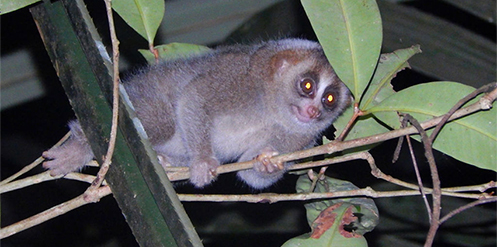May 08, 2018
Meet the Sunda slow loris (Nycticebus coucang), known in Indonesia as kukang, or malu-malu (meaning ‘shy’ in Indonesian). It is a mammal, native to Indonesia, Peninsular Malaysia, Singapore and Thailand, and capable of living up to 20 years in the wild.
The Sunda slow loris is one out of the 718 biodiversity species which have been identified in the Restorasi Ekosistem Riau (RER) area within the Kampar Peninsula.
It is recognizable by its dark rings around its large eyes, which have a special layer which reflects light. The slow loris has fur ranging from light brown to deep reddish brown in colour, and weighs around 600 g.

Like humans and apes, the Sunda slow loris is a primate with opposable thumbs, allowing it to grip onto tree branches. The Sunda slow loris gets its name from its characteristically slow movements between the branches, in a unique manner described to be similar to crawling.
The Sunda slow loris, like other slow lorises, is an arboreal animal – which means it lives in trees – and nocturnal – resting during the day in tree forks or in thick vegetation areas in dense forests.
With an extremely low metabolic rate compared to other mammals in Kampar Peninsula, the Sunda slow loris’ diet consists of fruit, insects, floral nectar and tree sap.
As part of the slow loris family, the Sunda slow loris is capable of producing a toxin in glands on the inside of their elbows, making slow lorises the only primate species which is venomous.
The toxin is used for protection against predators by the Sunda slow loris in two ways – either on its own fur or on the fur of its babies, so that the babies stay protected even when the mothers are away.
Yet, despite this, the Sunda slow loris’ main method of avoiding predators is simply through hiding.
Since 2008, the Sunda slow loris has held a Vulnerable (VU) status issued by the International Union for Conservation of Nature (IUCN). VU species are species with a very high risk of extinction with a current population size of fewer than 1,000 individuals.
It is also listed on Appendix I in CITES (Convention on International Trade in Endangered Species of Wild Fauna and Flora), an international agreement between countries which governs the international trade of wild animal and plant species. CITES I species are those threatened with extinction.
The Sunda slow loris is threatened with extinction due to habitat loss, but also more pressingly, a growing demand in the exotic pet trade, particularly in Indonesia. It is sometimes used in making illegal traditional medicine, believed by some to cure as many as 100 diseases.
Here's the beautiful #SlowLoris in our #restoration area. #DoYouKnow they can live up to 20 years in the wild & can produce a toxin to protect themselves. See more amazing facts here https://t.co/J2EIvgVuML #wildlife #Indonesia pic.twitter.com/Cc0SIaJljE
— RER (@RER_official) May 11, 2018